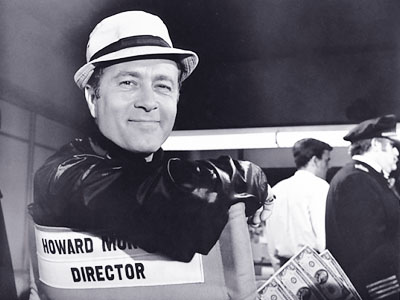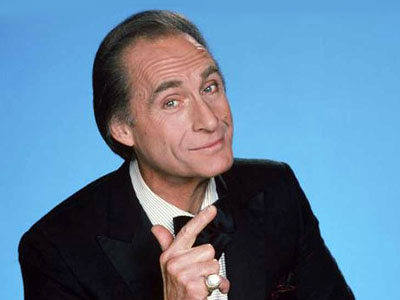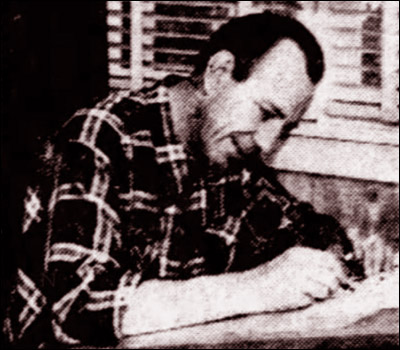Because of a looming deadline, I stand to not have very much blogging time this weekend so I thought I'd repeat an article that appeared here on February 17, 2014. This was not long after the passing of one of television's greatest comic talents, Sid Caesar. What follows got a lot of mail and a lot of links and attention then so maybe you'll enjoy it now. Or maybe you'll do what I might do and just click away and find a website with new content today…
![]()
Today, I want to start with two similar anecdotes that one hears in or about Hollywood. Both deal with the not-uncommon situation where someone who is older and accomplished has to audition for someone who is young and perhaps not well-informed about the person who is there to try out for a job.
In one, the older/accomplished person is the great director, Billy Wilder. In it, Wilder has come in to talk to a much younger studio executive about perhaps directing a project. The much younger studio exec says, "Thank you for coming in, Mr. Wilder. I'm afraid I'm not familiar with your work. Could you give me a brief rundown of what you've done?"
To which Mr. Wilder replies, "You first."
In the other, the older/accomplished person is the actress Shelley Winters and the much younger person is a casting director. The casting director asks pretty much the same question of Ms. Winters —
— and Ms. Winters, who has had these auditions before and is sick of them — reaches into an enormous purse she's carrying and hauls out the Academy Award she received for The Diary of Anne Frank and the Academy Award she received for A Patch of Blue. She slams them down on the casting director's desk and says, "That's what I've done!"
I can't say for sure that either of these stories is true but they are widely-told and widely-believed. I've also heard a version in which it was Wilder who brought his Oscars to the meeting and when asked what he'd done, brought out his for The Apartment, Sunset Boulevard and The Lost Weekend, plus his Irving Thalberg Award. In any case, that question is asked of veterans too often. Show Business is all about selling yourself and if you're around for any length of time, you will eventually be selling yourself to people who are much younger and don't know who the hell you are. A lot of older folks have a chip of massive proportions on their shoulders over this.
In 1983, I was auditioning voice actors for a cartoon special I'd written and would be voice-directing. In fact, it was my first voice-directing job. I had written all the major roles with specific actors in mind and would have been happy to just cast them without forcing them and a host of others to traipse into a studio in Burbank on a very hot day to audition. But the network insisted I read and record at least three actors, including my first choices, for each part. One of the actors I knew I wanted was Howard Morris so we called him in.
You know Howard Morris. That's because if you come to this weblog, you're a well-read, intelligent human being. Alas, in 1983, Howie was 64 years old and hadn't been appearing on television or in movies with any regularity. He felt he was spending his life auditioning for a stream of folks too young to have seen Your Show of Shows or any of the other fine things he'd done.

I had met Howie before, most recently when I was eleven years old. That day in '83, I was 31 but I probably looked 11 to him. He was, as I would learn, a wonderful, sweet man but he had a temper — a bad one at times. A lot of things pissed him off and a biggie was, as he put it, "auditioning for teenagers." A man of great accomplishments, it drove him crazy that the whole question of whether he worked — whether he got to do what he loved and what paid his bills — was in the hands of children who were too often unaware of those accomplishments.
So when I said to him, "Mr. Morris, it's an honor to have you here," he fixed me with a confrontational stare and tone and said, "Oh, yeah? You have no idea who the fuck I am."
Ah, but we were even: He had no idea who the fuck I was, either. He didn't know he was there to read for a guy who'd written the part with him in mind because I was so very familiar with his work.
He also didn't know he was there to read for a guy with a great memory and an obsession with the entertainment industry, comic books and cartoons included. That has been one of the Secret Weapons of my career. The first time I met Jack Kirby, he was impressed with how much I knew about the comic book field. When I went to work for Sid and Marty Krofft, they too were startled by the history (some would call it trivia) I could come up with about them and the folks with whom they worked. Marty found it especially useful when we were courting guest stars to appear on our shows. One time, he introduced me to Jerry Lewis and said, "Mark here knows every single thing you've ever done." I didn't but I knew enough to more than flatter Jer.
So I told Howie, "I know who the fuck you are. You were on Your Show of Shows with Sid Caesar and then you did Caesar's Hour with him. You were in Finian's Rainbow on Broadway and you directed the pilot for Get Smart and lots of episodes of shows like Hogan's Heroes and The Dick Van Dyke Show. You played Ernest T. Bass on five episodes of The Andy Griffith Show and directed a couple of them, too. You were in The Nutty Professor and you also directed a bunch of movies including Don't Drink the Water, Goin' Coconuts with Donny and Marie, With Six You Get Eggroll with Doris Day and one of my favorites, Who's Minding the Mint? You were the voice of Beetle Bailey on his cartoon series and then you were Jet Screamer on The Jetsons and you were Atom Ant and you were Mr. Peebles, the pet store owner who kept trying to sell Magilla Gorilla and you were the voice of the koala bear in all those Qantas Airlines commercials and you directed most of the McDonaldland commercials and you were the voice of about half the characters in them and can we get on with this audition so I can get you in my show now that I've proven I know who the fuck you are?"
We were friends from that moment on. And he was great on that show and others I used him on. I really loved the guy.
But there was one disadvantage to being around Howie. You had to keep listening to the Shelley Winters anecdote, which he told constantly. I must have heard it from him fifty times. Because he was so mad at having to audition for people who didn't know who the fuck he was.
The last two decades of his life, Howie did not work as much as he wanted to and I suspect that attitude was one of the reasons why. I don't mean the attitude of producers and casting directors who hadn't bothered to familiarize themselves with his résumé. I mean his attitude, as expressed to me when he came in for his audition with me. 95% of the time, that would cause the person with hiring power to think, "Well, this guy would sure be a lot of trouble."
It wasn't just that he was confrontational and occasionally angry. It's that when someone walks in the door clinging to long-ago accomplishments, you wonder if they're capable of turning loose of the past and living in the present. Howie certainly was. Once he felt he was among friends, he was a pussycat…a very talented pussycat. Not everyone is.
On one project I worked on for a few days, I found myself writing sketch comedy with a guy who'd been at it since about the time I was born. I started to tell him an idea I had for a skit about two friends and one of them owes the other some money. Before I'd said much more about it than that, he interrupted me and said, "Oh, yeah…the money-owing bit. I did it with George Gobel. I can just write it up."
I knew the routine he was recalling. It was an old burlesque sketch that turned up in a lot of early TV shows and it wasn't at all what I had in mind. But that was all we were going to get out of this guy. We were not, by the way, writing for George Gobel…or anyone who worked in his style.
There's a difference between bringing experience to a project and bringing a stubborn denial that things change…and should. I know an older writer (meaning: older than me) who had a personal Golden Age in the sixties and seventies writing detective shows like The Name of the Game and Cannon and Barnaby Jones. Every time I run into him, he starts in bitching about how "these damn kids" who are now the producers and show-runners won't hire him to write the cop shows of today.
To him, it's pure Ageism…and I don't doubt there's some of that. There's a lot of Ageism out there. But if he does have a chance to get any work these days, it isn't helped that he so obviously doesn't want to write the current shows. He wants to write Banacek.

The other day when Sid Caesar died, I wrote a piece here about how every time anyone hired him, his natural instinct was to turn whatever he was doing into a sketch from 1957. No one doubted his talent. A lot of producers just doubted he could or would do their show instead of doing his show. Let me give you an amazing example of this. Some of you are going to think I'm making this up…
Sid wrote his autobiography twice. I haven't read the second one but in the first one, which he called Where Have I Been?, you can read the following beginning on page 261 of the original hardcover…
…I was called over to Paramount Studios to meet with two TV producers who had sold ABC a pilot for a new situation-comedy series. I was told they had been associated with Taxi, a series I thought was quite good. Their new show was about a bar and the quaint characters who hung out in it. I was to be one of the quaint characters.
I had read the script, which they sent over in advance, and I didn't like it very much. The role they had in mind for me, in particular, was pure cardboard, strictly one-dimensional. But I saw some promise in it if I could be allowed to add some of my own shtick. So I went over to see the producers.
I expected to be meeting with Jim Brooks or Stan Daniels, two top talents, who, in addition to creating Taxi had previously been involved with The Mary Tyler Moore Show, among others. Instead, I found myself in a room with a couple of twenty-five year olds who seemed to know of me only from a part I had played in the movie Grease in 1977. I soon realized that, like so many of their generation in the industry, their concept of comedy did not go back beyond Gilligan's Island, on which they had been raised as children.
I said, "I have a few ideas to make my part a little more interesting and meaningful." They stared at me coldly and said, "We're perfectly satisfied with the part as we wrote it, Mr. Caesar." I felt my temper rising, but I controlled it. I went through the motions of having an amiable chat with them before I got up and said, "OK. That's it. Thank you. Goodbye." They were startled. Actors don't walk out on the almighty writer-producer when a possible five-year series contract is being dangled in front of them.
But I figured the concept was so poor it probably never would make it to a series anyway. Besides, even if it did, who would want to be associated with such shit?
And that is why Sid Caesar was not a regular cast member on that unsuccessful piece of shit, Cheers.
I mean, you figured it out, right? It wasn't on ABC. It was NBC. And it wasn't a five-year series, it was eleven, during which it was maybe the most acclaimed situation comedy on the air. But the show he walked out on with such disgust was Cheers. It went on the air about the time his book came out and it stayed on for a long, honored time.
The producers he met with were almost certainly Glen and Les Charles, who were not twenty-five years old. Glen was 39 and Les was 33. (When Sid Caesar started on Your Show of Shows, he was 28 and Mel Brooks was 24.) By this point, the Charles Brothers had not only produced Taxi — a show he and most of the country thought was "quite good" — but they were also writers for The Bob Newhart Show, the one where Bob played a psychologist. That was a rather fine show, too.
Giving Sid the benefit of every doubt, maybe the pilot script he'd read wasn't as wonderful as the eventual series. The role in question was reportedly Coach and it may at that stage have been somewhat different from what Nicholas Colasanto wound up playing.
Still, Caesar had been around TV long enough to know that scripts — especially pilot scripts — get rewritten and rewritten and rewritten. He'd done the Broadway show Little Me, which Neil Simon rewrote extensively throughout rehearsals and tryouts. Things change as you cast roles and get into rehearsals and the project takes shape. That's why when you consider signing on for a project, you take into account the reputation and talents of the folks you'll be working with. You trust in their ability to fix that which needs to be fixed…especially when they've just done a successful show you thought was "quite good."
(I've only met the Charles Brothers once, by the way, and don't really know them. But they're very bright, nice guys and I'll bet you they knew exactly who Sid Caesar was. Just as I'll bet they didn't learn comedy from watching only Gilligan's Island.)
The tragedy, of course, isn't just that Sid walked out on one very popular, highly-honored series. It's that for the rest of his career, any time some producer said, "Hey, why don't we get Sid Caesar for this role?," someone probably told him about the way Sid had treated the Charles Brothers. Which meant that the producer said, "Well, let's see who else might be available…" The anecdote not only suggested he'd be difficult to work with but also that he was hopelessly out of touch with what current audiences would like.
And had he been on Cheers, a couple of new generations would have known him and that would surely have translated into offers for other TV shows and for movies. Look at what being known from being on a current series, even as a guest star, has done for Betty White and Jerry Stiller and Shelley Berman and even Sid's old cohorts, Carl Reiner and Mel Brooks. This is on top of the millions and millions of dollars and probable Emmy Award(s) Sid would have had from being on Cheers instead of sitting home, stewing about how there was no place for him on television.
None of this is to suggest that there isn't a lot of Ageism in the entertainment industry…or that there aren't plenty of people in power who don't know a whole lot about the history of their business. But there are know-nothing bosses everywhere in every walk of life. If you try to avoid them all, you'll never get a job…and sometimes, you're wrong about them the way Sid was wrong about the guys who had that show set in a bar.
The world keeps turning and you have two choices: You can turn with it or you can spend your time trying to shove it back in the other direction. Since no one has ever succeeded at that yet, I don't know why people — especially people who could be as brilliant as Sid Caesar — keep trying. Besides, it's so much fun to hop on and go along for the ride, especially when the alternative is being left behind.



